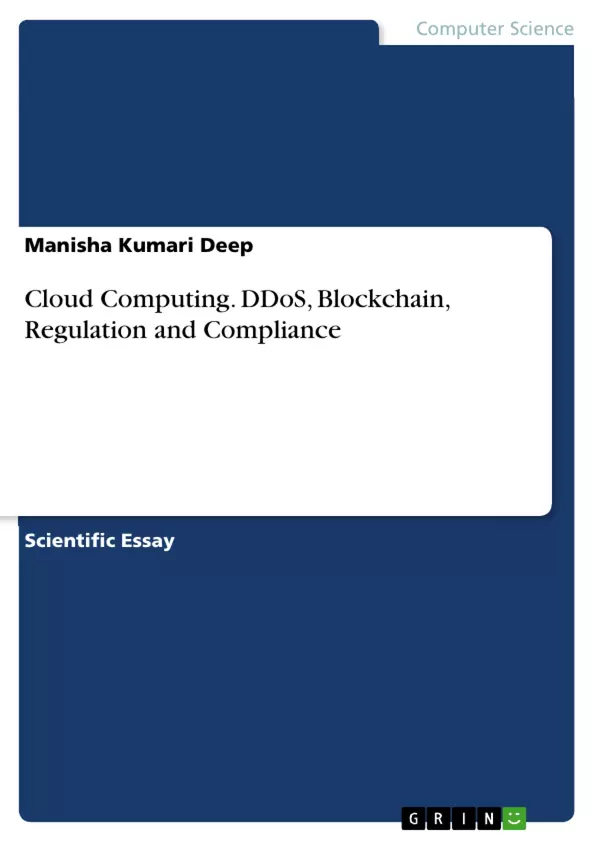Cloud computing is a promising technology where computational power is provided over internet as per users demand just like the supplies daily utilities of tap water, electricity and gas provided as pay per use. The features of easy accessibility anywhere at any time and almost no burden of on-going operational expenses like running of data-centre makes it one of the fastest growing technologies with the overall business of cloud being anticipated to be above $40 billion by 2012.
Here, cloud computing and its types have been discussed along with two emerging cloud deployment models and two emerging cloud service models. Block chains, Organic Network, Dynamic Trust Management Method (DTMM) and Cloud Compliance have been elaborated. Though data protection laws can be different with change in jurisdiction but here emphasis has been given on data policies existing in India based on IT Act (2000). Finally a reference model has been suggested for avoiding DDoS and Blockchain DDoS Attacks in Cloud Environment. The discussions has been concluded highlighting the recommendations and necessary actions needed for the same.
Other Reads by the Author
The Trial of Hope (Amazon)
An Alien Land (Kobo)
2 Moms (Kobo)
Unfolding Disaster (Kobo)
Walk to School (Kobo)
51 Points in Raising Awesome Kids (Kobo)
Organic IT Infrastructure Planning and Implementation (Amazon)
Grin Books
Positive Employee Recruitment and Retention Vital for Organizations
Digital India Mission. Implications on Social Inclusion and Digital Citizenship
Cloud Computing. DDoS, Blockchain, Regulation and Compliance
Organic eLearning (OE-Learning)
The Way of Prime Minister Narendra Modi's Leadership
Feasibility Study between Continuous Adaptive Risk and Trust Assessment and Organic Networks
I am my supervisor’s slave: Supervisor subordinate relationship is vital for organizational efficiency
Brands and their Shockvertisement Strategies
The Future of Blockchain in Banking
Social Media Marketing: Author’s Quandary Decoded (Amazon)
Inhaltsverzeichnis (Table of Contents)
- Cloud
- DDoS Attacks in Cloud.
- Blockchain for Cloud...
- Organic Networks – merger of ‘viral and social networks [20].
- Using Private Blockchain with DTMM in Cloud Platform…..\nCompliance in Cloud.
Zielsetzung und Themenschwerpunkte (Objectives and Key Themes)
This document aims to address the challenges posed by security, compliance, and threats in the realm of cloud computing, highlighting the potential of blockchain technology to mitigate these issues. It examines the need for secure data management and regulatory compliance within the cloud environment, particularly focusing on the context of India's IT Act (2000). The document delves into the vulnerabilities associated with DDoS attacks and proposes a blockchain-based solution to combat them.
- Security and compliance in cloud computing
- DDoS attacks and their impact on cloud infrastructure
- Blockchain technology as a solution for securing cloud environments
- Compliance with data protection laws and regulations, particularly the IT Act (2000) in India
- Dynamic Trust Management Method (DTMM) in the context of cloud and blockchain
Zusammenfassung der Kapitel (Chapter Summaries)
- Cloud: This section introduces the concept of cloud computing, its benefits, and challenges. It discusses the evolution of cloud technology, the different deployment and service models available, and the importance of understanding data retention policies.
- DDoS Attacks in Cloud: This chapter highlights the vulnerabilities of cloud environments to DDoS attacks. It provides an overview of the various types of cloud attacks and discusses the growing prevalence of DDoS attacks as a means for cybercriminals.
Schlüsselwörter (Keywords)
Cloud computing, DDoS attacks, blockchain, compliance, data protection, IT Act (2000), DTMM, security, privacy, regulatory requirements, virtualization, deployment models, service models, data retention, data transfer, data storage, data deletion, India.
- Quote paper
- Manisha Kumari Deep (Author), 2018, Cloud Computing. DDoS, Blockchain, Regulation and Compliance, Munich, GRIN Verlag, https://www.grin.com/document/416755



